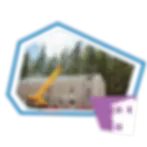
Cultivating Community
Conserving the Basin
That's what this project is all about. Cultivating Community, Conserving the Basin is the Tahoe Regional Planning Agency's latest Tahoe Living project to improve our environment and help bring more affordable and workforce housing to the Lake Tahoe Region. Explore this website to learn more about the project and get involved!
WHO WE ARE
What is "Cultivating Community, Conserving the Basin?"
At the Tahoe Regional Planning Agency (TRPA), we recognize that affordable housing is vital for the health of our communities and environment. Many who live and work in the Lake Tahoe Basin are affected by the housing crisis, particularly workers who must commute in from neighboring cities and those who experience sub-standard housing conditions. To address this, TRPA has embarked on a multiyear project to update the Lake Tahoe Regional Plan, making housing more accessible while maintaining and improving environmental protections. The Cultivating Community, Conserving the Basin project promotes equity and climate resilience through improved growth management and meaningful community engagement. Together, we can ensure that everyone in Lake Tahoe has access to affordable, sustainable housing in thriving communities and a healthy environment.

WHY WE'RE DOING THIS
Tahoe's Current Housing Environment
Since 2020, TRPA’s Tahoe Living strives to manage growth in new ways to address current environmental and community needs. Earlier work focused on policy changes that addressed accessory dwelling units (ADUs) and zoning incentives for affordable and workforce housing. In 2023, the Tahoe Living Working Group identified TRPA’s development rights system as needing improvement to better address housing access.
The current development rights system has been instrumental in limiting growth and protecting the environment. Increasingly however, large homes and resorts are taking up the largest share of available development rights, while smaller homes and “missing middle” housing are essentially outcompeted.
Cultivating Community is an opportunity to ensure the development rights program works for everyone, supporting the types of housing our community needs while improving environmental outcomes.

WHAT'S NEXT
Tahoe Living Engagement Process
By engaging in conversations around our Regional Plan, you can bring forward important changes in the Tahoe Basin to support your family, your community, and our region’s future. Throughout 2024 and 2025, there will be opportunities to weigh in on the project. We hope to see you soon at a neighborhood meeting, community event, TRPA meeting, or to hear from you through other opportunities. The agency is committed to making sure our engagement process is intentional and equitable so that every community member can weigh in.

Cultivating Community, Conserving the Basin Scholarship Program
Applications are OPEN and will be accepted on a rolling basis, subject to available funds.
Applicants have the option to submit responses in audio, video or written format. See eligibility and other requirements below. Awards Available
-
Reimbursement will be provided up to $1,600 per individual for up to 20 hours of participation
Growth Management Briefing Book
Check out the Growth Management Briefing Book which consolidates key findings from technical analyses and summarize areas of opportunity for updating TRPA’s regulations to achieve project outcomes related to resilient communities and environmental protection, housing choice, building trust, and equity. This briefing book builds upon key issues and recommendations from the Tahoe Living Working Group, the community, and TRPA staff and other partners, and will be used as a tool for crafting new policy concepts for consideration.


HOUSING NEEDS SURVEY
Regional Housing Needs Assessment
Tahoe Truckee Community Foundation (TTCF) and Tahoe Regional Planning Agency (TRPA) have launched a new regional housing survey as part of an updated assessment of housing needs in the greater Lake Tahoe Region. Responses will remain anonymous and general results will be shared with housing partners and made available on TTCF’s website at ttcf.net and the TRPA website at trpa.gov/housing.
The survey only takes a few minutes and will be open through May 30th, 2025.

HOUSING NEEDS SURVEY
Regional Housing Needs Assessment
Tahoe Truckee Community Foundation (TTCF) and Tahoe Regional Planning Agency (TRPA) have launched a new regional housing survey as part of an updated assessment of housing needs in the greater Lake Tahoe Region. Responses will remain anonymous and general results will be shared with housing partners and made available on TTCF’s website at ttcf.net and the TRPA website at trpa.gov/housing.
The survey only takes a few minutes and will be open through May 30th, 2025.

HOUSING NEEDS SURVEY
Regional Housing Needs Assessment
Tahoe Truckee Community Foundation (TTCF) and Tahoe Regional Planning Agency (TRPA) have launched a new regional housing survey as part of an updated assessment of housing needs in the greater Lake Tahoe Region. Responses will remain anonymous and general results will be shared with housing partners and made available on TTCF’s website at ttcf.net and the TRPA website at trpa.gov/housing.
The survey only takes a few minutes and will be open through May 30th, 2025.
WHO WE ARE
What is "Cultivating Community, Conserving the Basin?"
At the Tahoe Regional Planning Agency (TRPA), we recognize that affordable housing is vital for the health of our communities and environment. Many who live and work in the Lake Tahoe Basin are affected by the housing crisis, particularly workers who must commute in from neighboring cities and those who experience sub-standard housing conditions. To address this, TRPA has embarked on a multiyear project to update the Lake Tahoe Regional Plan, making housing more accessible while maintaining and improving environmental protections. The Cultivating Community, Conserving the Basin project promotes equity and climate resilience through improved growth management and meaningful community engagement. Together, we can ensure that everyone in Lake Tahoe has access to affordable, sustainable housing in thriving communities and a healthy environment.
WHY WE'RE DOING THIS
Tahoe's Current Housing Environment
Since 2020, TRPA’s Tahoe Living strives to manage growth in new ways to address current environmental and community needs. Earlier work focused on policy changes that addressed accessory dwelling units (ADUs) and zoning incentives for affordable and workforce housing. In 2023, the Tahoe Living Working Group identified TRPA’s development rights system as needing improvement to better address housing access.
The current development rights system has been instrumental in limiting growth and protecting the environment. Increasingly however, large homes and resorts are taking up the largest share of available development rights, while smaller homes and “missing middle” housing are essentially outcompeted.
Cultivating Community is an opportunity to ensure the development rights program works for everyone, supporting the types of housing our community needs while improving environmental outcomes.
WHAT'S NEXT
Tahoe Living Engagement
Process
By engaging in conversations around our Regional Plan, you can bring forward important changes in the Tahoe Basin to support your family, your community, and our region’s future. Throughout 2024 and 2025, there will be opportunities to weigh in on the project. We hope to see you soon at a neighborhood meeting, community event, TRPA meeting, or to hear from you through other opportunities. The agency is committed to making sure our engagement process is intentional and equitable so that every community member can weigh in.

The Latest
Find the latest on events, news, and project updates here.
An upcoming Tahoe Living Working Group meeting will be announced soon!
Tahoe Housing Statistics
Renting or owning a home in the Tahoe Region is becoming more difficult. This reality especially impacts low and moderate-income households and Black, Indigenous, People of Color (BIPOC) communities. The statistics below show key aspects of the Tahoe housing landscape.
Low and moderate- income housing needs make up more than half of the total housing need for the region.
Follow the link to view a table that depicts the total number of housing units (one single-family home, one apartment, etc.) that need to be built within the next six years to meet the region’s housing needs.
AMI = Area Median Income
57% of Black, Indigenous, and Other People of Color (BIPOC) rent in Tahoe compared to 35% of White Alone. This is 20% higher than the regional average of people who rent.
This chart depicts homeownership/rent in White alone individuals versus BIPOC individuals in the basin reported by the US Census Bureau.
Increasing housing costs forces local workers to move to surrounding areas, commuting into the Tahoe Basin and increasing greenhouse gas emissions. Increasing affordability should make it easier for people to stay in Tahoe.
This map shows commute patterns, based on home locations (in green) and work locations (in red) reported by the U.S. Census Bureau.





